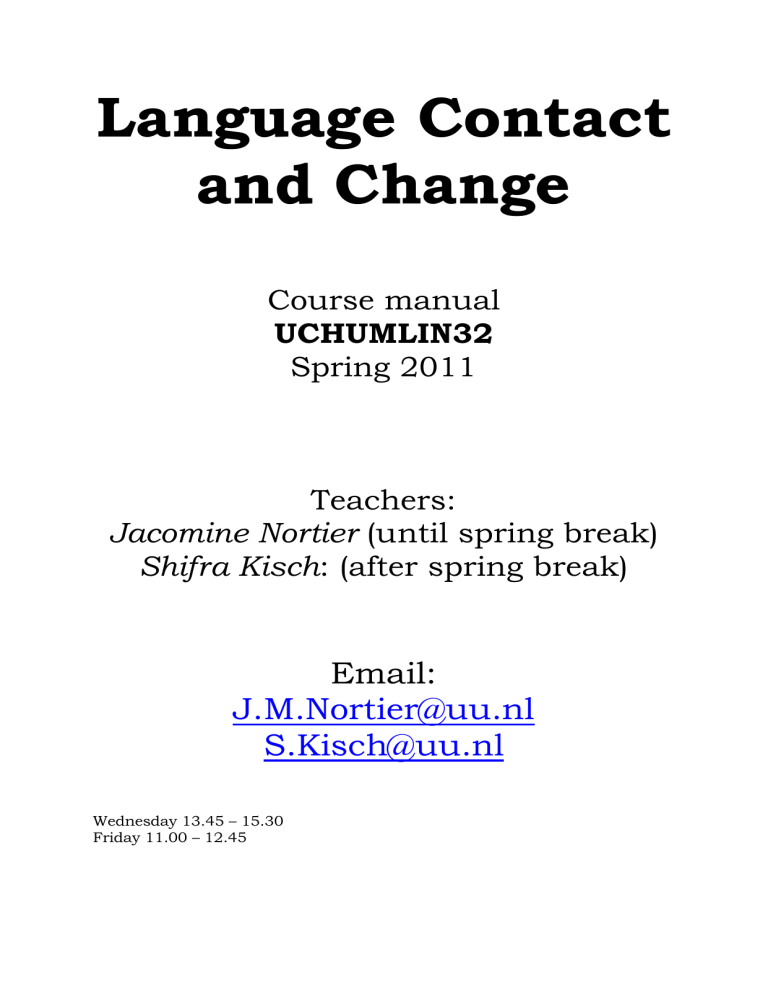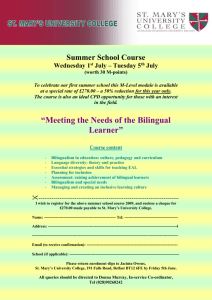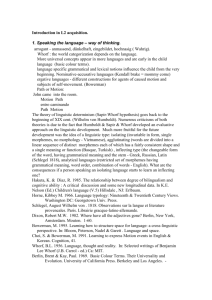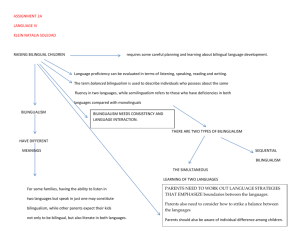Friday 11.00 – 12.45

Language Contact and Change
Course manual
UCHUMLIN32
Spring 2011
Teachers:
Jacomine Nortier (until spring break)
Shifra Kisch: (after spring break)
Email:
J.M.Nortier@uu.nl
S.Kisch@uu.nl
Wednesday 13.45 – 15.30
Friday 11.00 – 12.45
Literature for student presentations is not included there. Literature and topics for part 2 (after spring break) will be added later. Below you will see a schematic overview of part 1 of the course:
DATE TOPIC READ/PREPARE
Week 1
We 2 Feb
Fri 4 Feb
Week 2
We 9 Feb
Fri 11 Feb
Week 3
We 16 Feb
Fri 18 Feb
Week 4
We 23 Feb
Fri 25 Feb
Week 5
We 2 March
Fri 4 March
Week 6
We 9 March
Fri 11 March
Week 7
We 16 March
Fri 18 March
Introduction and check of linguistic knowledge
Course manual; an
Introduction to linguistics
(if you didn’t take an
Dialect and standard; bilingualism introductory course)
Background on bilingualism: read Myers-
Language policy and planning
Scotton (2006) Ch. 1 and
3: 1-15 and 35-66
DeWaele, Housen & Li Wei
(eds.) Ch 6 by Colin Baker
(88-111); Appel &
Muysken Ch. 5 (46-58)
Short presentations by all students, two by two, about language policy in a specific country/area (own choice). Use theory from A&M, Ch. 5: obligatory! (Max.
15 minutes per couple!)
Language shift, maintenance and loss
Myers-Scotton, Ch. 4: 67-
107
Presentation by three students. Advised literature:
(chapters from) Smits: Disintegration of inflection (on
Iowa Dutch) and/or El Aissati: Language loss among
Moroccans in NL
Foreigner talk Ferguson 1975; Snow et al. 1981.
Code-switching Read: Nortier 1994
(Introduction to CS) and
Poplack (1980)
Presentation by three students. Advised literature: choose some articles (ch 9, 10 or 11) from The
Bilingualism Reader (Li Wei, ed.) and/or Peter Auer
(ed.) CS in Conversation and/or special Issue of Intl.
Journal on Bilingualism 9, 3&4 (2005)
Creole languages and mixed languages
Wardhaugh: Ch 3, 54-85
No class!!!
Presentation by three students about creole languages.
Literature suggestions: parts from Arends et al. (1994) and/or v. Rossem & v.d. Voort (1996)
Language and ethnicity;
Youth languages
Hewitt (1992) and Cutler
(1999), republished in
Harris & Rampton (eds)
2003, 188-198 and 314-
327.
Presentation by three students about ethnic varieties.
Choose articles from IJB special issue (2008)
2
Grading:
11 February: Short presentation on language policy. (14%)
Presentation with two other students on a specific topic (18 February or 2, 11 or 18 March) (40%). Will be explained at first meeting.
Group work: Five times, at the end of some (not all) class meetings, you will work on a discussion question where you have to make use of the literature, together with one or two class mates. Hand in. These assignments will be graded. The lowest grade will be excluded so the average will be based on four out of five grades. This means that you are ‘allowed’ to miss one in case of absence, illness etc. (together:
16%, 4% per assignment).
Essay: Choose one of the following focus points: o social class o ethnicity o cultural capital o grammar and discuss your topic in relation with one of the course themes in the first half of this course (before spring break): An example: you may write an essay about the relation between Social Class (= focus point) and Foreigner Talk or Creole Languages (course themes). Or it is, for example, about Cultural Capital (focus point) and Creole
Languages or Youth Languages (course themes). The length of your essay should be between 3000 and 5000 words, and you have to begin with an introduction in which you clearly explain how your essay will be structured and what the aim of your paper is (research question).
Deadline: the end of spring break. (30%)
You are most welcome to suggest other topics for a paper, but please discuss with me first!
All papers have to have a clear research question as a starting point.
So please don’t just sum up a lot of information on a certain topic.
You don’t need to wait with your essay until the end of part 1. For example: if you find language shift or code-switching interesting, you can start with your paper in week 3 or 4.
These percentages will add up to a maximum of 100, which equals the
50% you can earn for the course until spring break.
Together this will be 50% of your final grade.
Until spring break
After spring break
DATE
11 Feb
WHAT
% of final grade
50
50 presentation about language policy (in
% of grade BEFORE spring break
14%
3
18 Feb or 2, 11 or 18
March
5 times of which lowest grade is excluded
Anytime before the end of spring break couples)
Presentation on specific topic – 3 students at a time
Group work during class, to be handed in
Essay. Individual.
40%
16%
30%
Literature
(to be obtained from the library) Keep an eye on your email!
Friday 4 February:
Myers-Scotton, Carol: ‘Introduction’,
C hapter 1 in Multiple Voices,
Oxford: Blackwell, 2006, p 1-15.
Myers-Scotton, Carol: ‘Who is a Bilingual? What Factors Promote
Bilingualism?’,
C hapter 3 in Multiple Voices, Oxford: Blackwell, 2006, p
35-66.
Wednesday 9 February:
Appel, René and Pieter Muysken: ‘Language Planning’, Chapter 5 in
Language Contact and Bilingualism, London: Edward Arnold, 1987, p
46-58.
Baker, Colin: ‘Language Planning. A Grounded Approach’, Chapter 6 in
Jean-Marc DeWaele, Alex Housen and Li Wei: Bilingualism: Beyond
Basic Principles. Clevedon: Multilingual Matters, 2003, p 88-111
Wednesday 16 February:
Myers-Scotton, Carol: ‘Language Maintenance and Shift’,
C hapter 4 in
Multiple Voices, Oxford: Blackwell, 2006, p 67-106.
Wednesday 23 February:
Ferguson, Charles, ‘Toward a Characterization of English Foreigner
Talk’. Anthropological Linguistics 17, 1975, p 1-14.
Snow, Catherine, Roos van Eeden and Pieter Muysken: ‘The
Interactional Origins of Foreigner Talk: Municipal Employees and
Foreign Workers’, International Journal of the Sociology of Language 28
(1981), p 81-91
Friday 25 February:
Nortier, Jacomine: ‘Dutch-Moroccan Arabic Code-switching in the
Netherlands’. Indian Journal of Applied Linguistics, 1994, 19 pages.
Poplack, Shana: “Sometimes I’ll start a sentence in Spanish y termino en Español”. In: Li Wei (ed.), The Bilingualism Reader, London:
Routledge, 2000 (originally from 1980), p 221-256.
Friday 4 March:
4
Wardhaugh, Ronald: ‘Pidgin and Creole Languages’, Chapter 3 in
Introduction to Sociolinguistics, Oxford: Blackwell, 1998, p 54-85.
Wednesday 16 March:
Hewitt, Roger: ‘Language, Youth and the destabilization of ethnicity’, in:
Roxy Harris and Ben Rampton, The Language, Ethnicity and Race
Reader, London: Routledge, 2003, p 188-199
Cutler, Cecilia: ‘’ Yorkville Crossing: White Teens, Hip Hop and African
American English’, in: Roxy Harris and Ben Rampton, The Language,
Ethnicity and Race Reader, London: Routledge, 2003, p 314-327
The Course
In this course the central topic is language contact, bilingualism 1 and language change as far as it is related to language contact. When people who speak different languages get in contact with each other, their languages are in contact as well. Usually at least one of the languages involved will be more or less affected by the other. This is a very common reason for language change.
In order to understand what is going on, multidisciplinarity is necessary. In this course you will be confronted with linguistic, socio-cultural and to a lesser degree with psychological perspectives on language contact and change.
The first part of the course will be taught by Jacomine Nortier, who is a sociolinguist at the department of Dutch Language and Culture. You will get acquainted with a variety of aspects of language contact and bilingualism. We will see how the outcome of language contact depends on both linguistic and social structure and how a government can give directions to linguistic developments by means of language planning measures. Patterns of dominance and the status of languages (in terms of majority versus minority) determine the type and direction of linguistic change, shift and influence. We will see how some languages make place for others in a process of language shift and how other languages maintain their shape and position.
Furthermore, the interface between multilingualism on the one hand, and ethnicity and identity on the other, will play a major role in the course.
We will also study the linguistic consequences of language contact. You are probably familiar with Foreigner Talk: the way native speakers talk to foreigners in order to make themselves understood (not always with the desired effect). We will look into linguistic borrowing and code-switching (the use of more than one language in a conversational setting or even within one sentence). Furthermore we will focus on the emergence of new languages.
Examples of such languages are creole languages, as a result of slavery and contact between a large number of languages that are mutually not understandable.
1 The terms bilingual(ism) and multilingual(ism) will be used as equivalents.
5
Rules:
You are not allowed to enter class:
when you are more than 5 minutes late
when you have not read the proscribed literature
6






